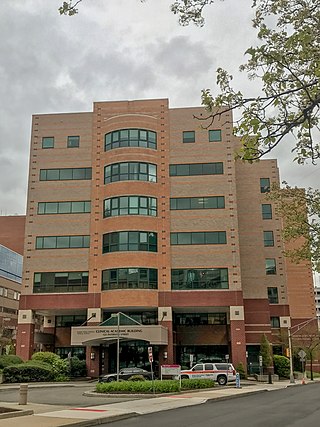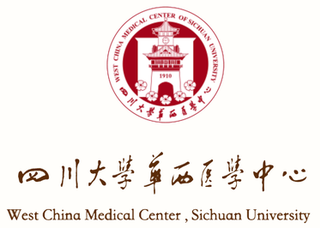The Association of American Medical Colleges (AAMC) is a nonprofit organization based in Washington, D.C. that was established in 1876. It represents medical schools, teaching hospitals, and academic and scientific societies, while providing services to its member institutions that include data from medical, education, and health studies, as well as consulting. The AAMC administers the Medical College Admission Test and operates the American Medical College Application Service and the Electronic Residency Application Service. Along with the American Medical Association (AMA), the AAMC co-sponsors the Liaison Committee on Medical Education (LCME), the accrediting body for all U.S. MD-granting medical education programs.

Loma Linda University (LLU) is a private Seventh-day Adventist health sciences university in Loma Linda, California. As of 2019, the university comprises eight schools and a Faculty of Graduate Studies. It is a part of the Seventh-day Adventist education system. The university is accredited by the WASC Senior College and University Commission (WSCUC). Its on-campus church has around 7,000 members.

The Universidad Autónoma de Guadalajara, Autonomous University of Guadalajara), commonly abbreviated to UAG or Autónoma, is a coeducational, independent, private university based in the Mexican city of Guadalajara. Established in 1935, it was the first private university and medical school in Mexico. The creation of the university was a conservative response to a more-left wing direction being taken in Mexico in public higher education at the time. It was first conceived with the name Universidad del Occidente, but would later be styled to Universidad Autónoma de Guadalajara (UAG).

Rutgers Robert Wood Johnson Medical School is a medical school of Rutgers University. It is one of the two graduate medical schools of Rutgers Biomedical and Health Sciences, together with New Jersey Medical School, and is closely aligned with Robert Wood Johnson University Hospital, the medical school's principal affiliate.


The University of Medical Sciences is a private medical university in San José, Costa Rica. It is the largest and oldest private medical school in Costa Rica and one of the most prestigious in Latin America. Currently the main campus is located in the country's capital with the latest technology in medical education and one of the best simulated hospitals in the region. The university offers a great variety of degrees such as Doctor of Medicine, Doctor of Microbiology and Clinical Chemistry, Licentiate of Physiotherapy, Licentiate of Nutrition and Doctor of Pharmacy. UCIMED also offers master's degrees and medical specialties such as a Master's Degree in Health Management and Specialty in Gynecology and Obstetrics.
Drexel University College of Medicine is the medical school of Drexel University, a private research university in Philadelphia, Pennsylvania. The medical school represents the consolidation of two medical schools: Hahnemann Medical College, originally founded as the nation's first college of homeopathy, and the Woman's Medical College of Pennsylvania, the first U.S. medical school for women, which became the Medical College of Pennsylvania when it admitted men in 1970; these institutions merged together in 1993, became affiliated with Drexel University College of Medicine in 1998, and were fully absorbed into the university in 2002.

Kansas City University (KCU) is a private medical school with its main campus in Kansas City, Missouri and an additional campus in Joplin, Missouri. Founded in 1916, KCU is one of the original osteopathic medical schools in the United States. It consists of both a College of Osteopathic Medicine and a College of Biosciences. KCU is one of the largest medical schools in the nation by enrollment.

The University of New Mexico School of Medicine is a division of the University of New Mexico Health Sciences Center located in Albuquerque, New Mexico. The UNM School of Medicine is home to a variety of degree-granting programs, including the only MD program in the state.
Medical school in the United States is a graduate program with the purpose of educating physicians in the undifferentiated field of medicine. Such schools provide a major part of the medical education in the United States. Most medical schools in the US confer upon graduates a Doctor of Medicine (MD) degree, while some confer a Doctor of Osteopathic Medicine (DO) degree. Most schools follow a similar pattern of education, with two years of classroom and laboratory based education, followed by two years of clinical rotations in a teaching hospital where students see patients in a variety of specialties. After completion, graduates must complete a residency before becoming licensed to practice medicine.

Universidad Juárez Autónoma de Tabasco is a public institution of higher learning located in Villahermosa, Tabasco, Mexico. The mission of the university is "to prepare professionals with broad and deep expertise in their area of study to fill the needs of Tabasco and the country at large." UJAT is the largest and most prominent university in the state of Tabasco. During the 2007-2008 academic year the university enrolled 35,271 students and had a teaching staff of over 2,000. For the same school year the university offered bachelor's degrees in 36 disciplines, master's degrees in 26 areas, three doctoral degrees, and post-graduate Certificates (Especialidades) in 17 graduate areas of specialization. The university grants law, education, management, engineering, medicine, architecture, nursing, and dentistry degrees, plus some 30 additional degrees in other fields of study.

The Consortium for North American Higher Education Collaboration (CONAHEC) is a non-profit membership organization which advises and connects higher education institutions interested in establishing or strengthening academic collaborative programs in the North American region.

The University of Florida College of Medicine – Jacksonville is the largest of the three University of Florida Health Science Center Jacksonville colleges — medicine, nursing and pharmacy. The college's 16 clinical science departments house more than 440 faculty members and 380 residents and fellows. The college offers 34 accredited graduate medical education programs and 10 non-standard programs.

The Paul L. Foster School of Medicine is a medical school in El Paso, Texas at Texas Tech University Health Sciences Center El Paso. The Paul L. Foster School of Medicine is the 9th medical school in the state of Texas, and the medical school is the first one to open in almost four decades. As a result of the numerous financial donations, as well as state funds, The Paul L. Foster School of Medicine has the ability to expand, construct new buildings and hospitals, purchase elaborate training equipment, and hire nationally respected professors. This academic staff is able to train current students through the utilization of state of the art educational and skill enhancing technologies that are considered to be pioneering the medical education process for the next several decades. An example of this ability is demonstrated through the advanced technologies employed in their large Clinical Simulation Center.

Bukovinian State Medical University is one of the largest institutions of higher education in the city of Chernivtsi, Ukraine. It is a modern multidisciplinary institution of higher medical education, included in the general register of the World Health Organization, the Great Charter of Universities, the European University Association, which trains applicants for higher education according to a step-by-step system of education
Peking University Health Science Center is the medical school of Peking University, which has 14 affiliated hospitals in Beijing, China. It was formerly the independent Beijing Medical University.

The West China Medical Center, Sichuan University, formerly the West China University of Medical Sciences, is a prestigious world-class public research institution of medical sciences located in Chengdu, Sichuan, China.

Ghulam Muhammad Mahar Medical College or GMMMC in short is the sixth public sector Medical college under the Government of Sindh where 100 students of Sukkur, Khairpur and Ghotki are getting education every year. It is named after Sindh politician Ghulam Muhammad Khan Mahar.

The Division of Health Sciences of the University of Quintana Roo is an academic division located 3.8 miles away from the main academic unit in Chetumal, Mexico, which houses the careers of Medicine, Nursing, and Pharmacy. It is the only academic division that simultaneously integrates three bachelor's degree programs in the study of health sciences in the Southeast region of Mexico. Due to its geographical proximity to other countries, it has a significant student population from Belize, Central and South America.















